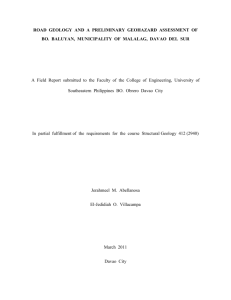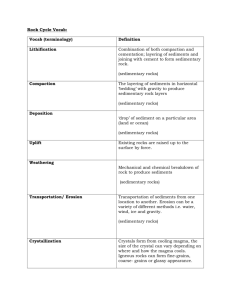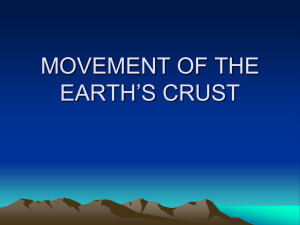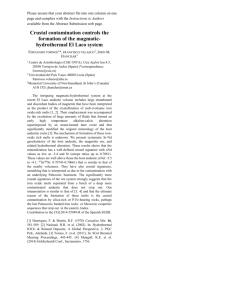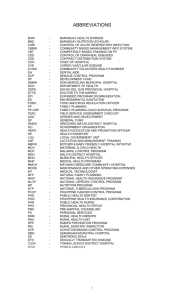1 ES-Research Sulop 2
advertisement
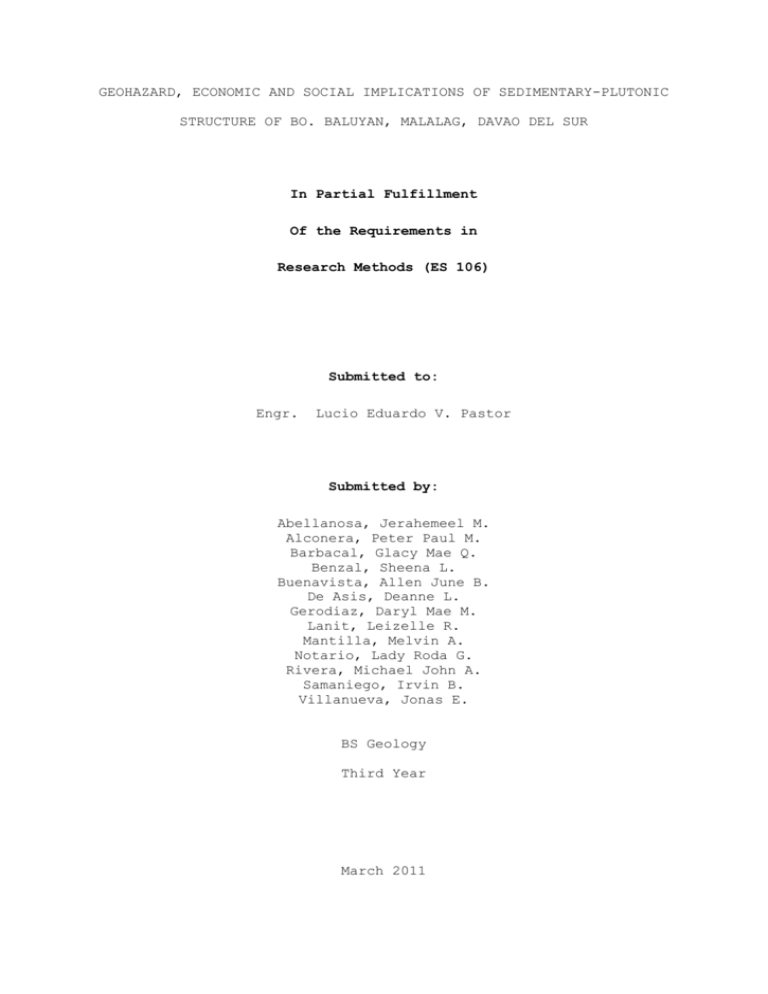
GEOHAZARD, ECONOMIC AND SOCIAL IMPLICATIONS OF SEDIMENTARY-PLUTONIC STRUCTURE OF BO. BALUYAN, MALALAG, DAVAO DEL SUR In Partial Fulfillment Of the Requirements in Research Methods (ES 106) Submitted to: Engr. Lucio Eduardo V. Pastor Submitted by: Abellanosa, Jerahemeel M. Alconera, Peter Paul M. Barbacal, Glacy Mae Q. Benzal, Sheena L. Buenavista, Allen June B. De Asis, Deanne L. Gerodiaz, Daryl Mae M. Lanit, Leizelle R. Mantilla, Melvin A. Notario, Lady Roda G. Rivera, Michael John A. Samaniego, Irvin B. Villanueva, Jonas E. BS Geology Third Year March 2011 Table of Contents Page I. Introduction a. Purpose and Scope b. Location and Accessibility c. Topography and Drainage d. Climate and Vegetation 1 1 2 2 2 II. Geology a. General Geology b. Tectonic Genesis 3 3 III. Structures 4 IV. Mineralization 4 V. Geohazard Assessment 5 VII. Social Implications 5 V. Conclusion 7 VII. Recommendations 9 VIII. Acknowledgment 10 IX. References 11 X. Figures a. Topographic Map b. Geographic Map of the Region c. Climate Map d. Neotectonic Map of Mindanao e. Geologic Map if Bo. Baluyan, Malalag, Davao del Sur f. Documentations 12 13 14 15 16 17 I. The Philippines is INTRODUCTION one of the countries located in the “Pacific Ring of Fire” where tectonic plates are actively moving and earthquakes, typhoons, and volcanic activities are frequently experienced. It is formed due to the collision of major tectonic plates to the Philippine microplate in major subduction zone. Subduction zone is a plate margin where two crusts collide with the denser crust subducting under the less densed crust. In the east, the Pacific plate subducts under the Philippine trench and in the west is the Eurasian plate subducts under the Philippine plate forming the Manila Trench. A Transform fault is also propagating from Northern Luzon to Sothern Mindanao called the Philippine Fault line. The Philippine trench in the east and the Cotabato trench in southwest encompassing the island of Mindanao on sea and a Mindanao fault is present on land trending southeast to northwest. In Sulop, Davao del Sur, a thrust fault that trends southeast to northwest passes the formations of sedimentary along the Baluyan zigzag road. A thrust fault is a low angle reverse fault with the hanging wall moving upward relative to the footwall. The sedimentary formations are mainly composed of silt-sandstone-shale with volcanic intrusions forming dikes and sills. Dikes are magma intrusions cutting across sedimentary beds while sills are magma intrusions intruding the contracts. Quaternary Alluviums, which are eroded rocks, are formed on the lowlands of the area. The researchers are going to investigate how these structures and lithologies in Sulop, Davao del Sur will benefit the people economically and socially as well as to assess geohazard and precautionary measures. Purpose and Scope The authors conducted the field investigation of the thrust sedimentary-volcanic structure on Bo. Baluyan, Malalag, Davao del Sur on February 6, 2011. The investigation was purposely conducted to determine and delineate the general geology and structure of the 2 area, geohazard risk assessment, economical and social implication brought about by the formation. The data were solely gathered on the road cuts situated at the Kawayan Hill to Luya Hill on the region. A 1:50,000 topographic map of Padada quadrangle with Sheet No. 4039- I was used as a reference map. Location and Accessibility Bo. Baluyan, Malalag, Davao del Sur is bounded by geographic coordinates 06°32’27’’ north latitude and 125°22’12.9’’ east longitude (Figure 1). It is southwest of central Davao City and approximately 45 km distance travel by commercial buses and other land vehicle for three (3) hours through Davao City – Sta. Cruz – Digos City – Padada – Sulop National Road (Figure 2). Topography and Drainage The topography of Malalag area and its vicinity is typically planar terrain with some moderately steep hill distributed throughout the region. The highest peak in the locale is reaching at about 800 m above sea level. The region is primarily drained by the Malalag river and some of its creeks and tributaries northwest towards the Malalag Bay. Dendritic Drainage pattern is observed in the region. Climate and Vegetation Bo. Baluyan, Malalag, Davao del Sur belongs to fourth (4th) type of rain condition which is characterized of having evenly distributed rainfall throughout the year. Tropical cyclones rarely occur in this region. Vegetation consists mainly of tropical rain forest trees, shrubs and vines on interior areas. Alluvial plains are cultivated by palays, corn, bananas, coconut and other fruit bearing tress for agricultural purposes. 3 II. Geology a. General The main lithologic unit in the area are interlingering of thrusted sedimentary rocks and volcanic intrusions. It was generally referred to as Sulop Formation (Milanes, 1981). The formation was redefined to include andesite intrusive and Mal clastics by the same author. The sedimentary beds are composed of detrital rocks such as sandstone, conglomerate, shale, siltstone and chert. The sandstone is typically of medium to course grained size, which is well sorted, compacted, and has greasy black appearance that could be mistakenly thought as basalt. It is moderately jointed and fractured. Veins and stingers of infills the quartz and fractures calcite, of the ranging sandstone at about rocks. 1-5mm size, Conglomerate is predominantly of couble to boulder ( 64- 256 mm) size sandstone clasts. It is thickly bedded and exhibits spheroidal weathering. The shale is well sorted, moderately compacted and has a brownish sediments. The siltstone predominantly composed of quartz grains that have been baked sideways relative to shales. Consequently, the extrusive rock is chloritized porphyrtic andesite which is moderately to deeply weathered. It is composed chiefly of augite, plagioclase feldspar, amphibole, biotite and some traces of muscovite. b. Tectonic Genesis The Sulop formation is part of the Padada- Malalag Sub basin which is assumed to act as the catchment basin is geologic past. The sediments are bedded, well sorted and compacted, signifying a marine depositional environment, even though traces of marine fossils are not found. The region was uplifted as a result of the compressional force acting on the eastward by the Saranggani Trench towards west and the Cotabato trench towards northeast (Figure 4). The andesite rocks intruding the clastic rocks is of Late Miocene age (7.25-11.61 4 mya) that is younger to the sedimentary sequence which is of Late Oligocene age (23.03-28.4 mya). The Sulop formation forms the bulk of the Saranganni Ridge System and was conformable to Bauyan Formation (MGB, 2004) III. Structures The general structure of the region is thrusted sedimentary layers and andesite bodies. The thrust fault is located at the eastern part of the Saranggani Penisula trending at NW-SE direction. Chaotic exhumation and upliftment of the rocks resulting to the formation of fault block mountains and hills. Furthermore, the intrusion of andesite body had also contributed to the upliftment of the region. Irregular bed dippings downward results the jointing of andesite and sandstone bodies. Fault traces, passing on andesite bodies, are aided by the formation of fault gouge is about 8-9 inch in thickness. The gouge signifies occasional movement of the fault in geologic time. It is reddish to brown in color which signifies stains in oxidation. The structure reveals also of anticlinal folds that strike at N 19’ W and dips at NE 54’. According to Milanes(1981), the clastic sequence in the region occupies the different flank of the Saranggani Anticinorium. Quartz and Calcite veins infills the moderately fracture andesites and sandstone which is pervasively seen near the fault zones. IV. Mineralization Economic minerals are not typically distributed and identified on the implies Chlorite deposits region. a But magmatic is a and the occurrence composition common mineral commonly with of the ore mineralizing associated occurs “chloritic” solution. with hydrothermal ore with epidote, adularia and sulfide minerals (Hulburt, 1985). andesite sericite, 5 Furthermore, occurrence of veins and stringers, calcite and quartz, in the area signifies replacements of mineral chemistry brought about by hydrothermal activities of the magmatic intrusions. In addition, presence of small amount of chert also indicates hydrothermal solutions associated in volanics (Huwang, 1980) The presence of reddish stains in weathered andesites and especially in gauge materials may indicate minute metallic deposits in the region. V. Geohazard Assessments The Sulop formation is elevated at about 200m -800m terrain. Geomorphically, it is relative at young-stage cycle reflecting to high denulation process to occur on the region. The lithology, mostly consists of detrital sedimentary rocks and intrusive, is dipped almost vertically jointed, fractured, possesses imminent along the spheroidally danger to road and the ways. deeply traveling The presence weathered vehicles and of rocks human infrastructures. Rock and debris fall will mostly likely to occur. Landslide exposures are observed with no tress and shrub growing. Slope failure will likely occur as the slope support is curbed for road ways construction. Talus deposits alongside reflect the pervasive weathering of the rocks. This also may possess dangers in prolonged duration of rainfalls. Since the region has type 4 climate pattern, the weathering of the rocks will be high. The thrust fault possesses also dangers when displacement occurs generating earthquakes that will trample down unstable rocks and debris causing landslides. VI. Social Implication Due to elevated topography of the region, resorts, restaurants, and other socially enriching businesses is of good economic market to be established in the area. The paranomic view of the Malalag Bay, Davao Gulf, Malalag- Pujada sub basin will surely generate income of interested and entice the people to appreciate 6 and admire nature and the Philippines as a whole. Religious congregations and meditative groups can also consider this place for reflection, relaxation and outdrawing of themselves to the world and its stresses. 7 VII. Conclusion Based on the observations and assessments, the authors have drawn the following conclusions: 1. Bo. Baluyan, Malalag , Davao del Sur constitutes generally of interlingering of thrusted sedimentary rocks and porphyritic andesite intrusions. 2. Sedimentary beds are composed of detrital rocks such as sandstone, conglomerate, shale, siltstone and chert. 3. Sulop formation is part of the Padada- Malalag Sub basin which is assumed to act as the catchment basin is geologic past. The region was uplifted as a result of the compressional force acting on the eastward by the Saranggani Trench towards west and the Cotabato trench towards northeast. 4. The andesite rocks intruding the clastic rocks is of Late Miocene age (7.25-11.61 mya) that is younger to the sedimentary sequence which is of Late Oligocene age (23.0328.4 mya). 5. The thrust fault is located at the eastern part of the Saranggani exhumation, Penisula trending upliftment and at NW-SE intrusion direction. of Chaotic andesitic rocks results to the formation of fault block mountains and hills. 6. Thrust faults and fault gouge is present generating the anticlinal folded structures. 7. The occurrence of the “chloritic” andesite and the veins & stringers implies an hydrothermal activities. ore mineralizing solution and 8 8. The presence of jointed, fractured, spheroidally and deeply weathered rocks possesses imminent danger to the traveling vehicles and human infrastructures. Rock and debris fall will mostly likely to occur. 9. Due to elevated topography of the region, resorts, restaurants, and other socially enriching businesses is of good economic market to be established in the area. 9 VIII Recommendations Based on the observations and assessments, the authors have drawn the following recommendations: 1. Irregular downward dippings and jointing of rocks in the region posses imminent danger. Engineering techniques such as concrete walls, bolts, etc. should be applied in areas of weak zones to prevent falls, slips and mass movements reducing the hazard of the area. 2. Curbing along the roadside should be minimized to prevent destabilization of the rock that may lead to mass movements. 3. Road signs such as landslide areas, debris falls, zigzag roads among others should be placed as warning signs for the road users to be aware. 4. From time to time, local geologist and the residence of the region should observe any minute mass movement in order to mitigate and reduce hazards in the locale. 5. Possible exploration for economic deposits in the region or near the region may be done due to the presence of chloritic andesite and veins and stingers. 6. Location of establishments, housing and settlements should not be located in geohazard areas. 7. Resorts, restaurants, and other socially enriching businesses is of good economic market to be established in the area. 10 XI. ACKNOWLEDGEMENT The authors would like to express their deepest gratitude to the following persons and institutions who in one way or another have contributed in realization of this field study: To the office and personnel of Mines and Geosciences Bureau Region XI for lending information on the local geology of Padada, Davao del Sur; To our respective families, for their consent, financial and moral support; To Mr. Jose D. Madrona, for his imparted knowledge, untiring efforts and guidance in the field; To Engr. Lucio Eduardo V. Pastor, for his guidance, supervision and assistance in making this research paper, and the people of Bo. Baluyan, Padada for their peaceful welcome; To Kent Albiso, Lemuel Libres, and El-Jedidiah Villacampa for their shared insights on the region visited; and to the unseen God, for His protection and guidance and giving this opportunity to study the marvels and beauty of His creation. 11 REFERENCES Mines and Geosciences Bureau(MGB) Region XI Davao City, April 1992,Geology and Mineral Resources of Davao del Sur Huang, W.T. 1950, Petrology, Classification of Sedimentary Rock, Chert, pp. 297, 1950 Hurlbut, C. Jr.1985, Dana’s Manual of Mineralogy, Desciptibe Mineralogy, Chlorite, pp. 445 13 Figure II Geographic Map of Region XI Bo. Baluyan, Malalag , Davao del Sur 14 Figure III Climate map Type I. There are two pronounced seasons: The dry season (from November to April) and wet season (rest of the year). Type II. There is no dry season under this classification, with a very pronounced rainfall from November to January. Type III. Seasons are not very pronounced. It is relatively dry from November to April, and wet during the rest of the year. Type IV. Rainfall is more or less evenly distributed throughout the year under this classification. 15 Figure IV Neo Tectonic Map of the Mindanao

